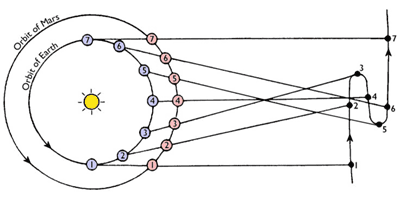The ancients knew that both Mercury and Venus were close to the Sun. They could only see them either in the morning or the evening. This is how they got the name of Morning Star or Evening Star. When they are the Morning Star, they rise just before the Sun and therefore, are only seen in the eastern sky. When they are the Evening Star, they set just after the Sun and therefore, are only seen in the western sky.
If the ancients believed that everything in the solar system orbited around the Earth, how did they explain how Venus and Mercury stayed close to the Sun? In the Ptolemaic model, the epicycles for both Mercury and Venus were connected to the Sun by a line.
This line was needed in the model to keep Venus and Mercury close to the Sun in the sky. Otherwise, in this model, Venus or Mercury and the Sun could be at opposition, which we know is not true.
When the Copernican Revolution occured and the heliocentric model came to prominence, the line was no longer needed. Since Mercury and Venus orbit the Sun and in the model, are closer to the Sun than the Earth, their proximity to the Sun in the sky is easier to explain.
We discussed the Phases of Venus in our last post and mentioned the greatest eastern elongation and the greatest western elongation. For Mercury and Venus, we use these terms to tell us the point in Mercury's and Venus' orbits when they appear the farthest from the Sun in the sky depending on their position relative to the Sun.
Greatest eastern elongation occurs
when Venus (or Mercury) is the farthest east of the Sun. When either planet is at greatest eastern
elongation, the planet is only visible from Earth just after sunset, which
means we only see it when it’s in the western sky. We call this the Evening Star.
Greatest western elongation,
however, occurs when Venus (or Mercury) is the farthest west of the Sun. When either planet is at greatest western
elongation, the planet is only visible from Earth just before sunrise, which
means we only see it when it’s in the eastern sky. We call this the Morning Star.
Remember that the terms refer to the planet’s position with
respect to the Sun in the sky, and not its location in the sky when it is
visible.
By comparing the position of Mercury or Venus to the Sun, we can determing the angle between the planet and the Sun at either greatest elongation. Venus cannot be any more than 47.8° from the Sun in the sky. At greatest western elongation, Venus rises about 2.5 hours before the Sun and at greatest eastern elongation, Venus sets about 2.5 hours after the Sun. Mercury cannot be any more than 27.8° from the Sun in the sky. At greatest western elongation, Mercury rises about 1.5 hours before the Sun and at greatest eastern elongation, Mercury sets about 1.5 hours after the Sun.
Note that these elongations occur when the planet is at aphelion. If either planet is at perihelion, the angle is smaller. For Mercury, greatest elongation at perihelion is only 18° and is visible an hour before or after the Sun rises or sets. For Venus, greatest elongation at perihelion is 45° which doesn't change its appearance before or after sunrise or sunset by much.
The reason for the huge difference for Mercury's elongations is its relatively elliptical orbit. Venus' orbit is closer to circular so the angles are much closer.









